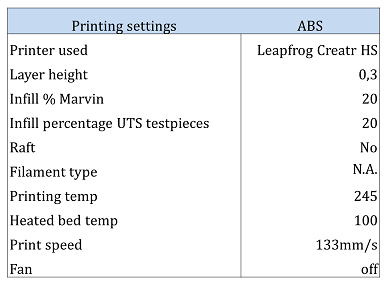Welcome back! After showing some pretty awesome results for printing with PLA last week, now it is time to focus on its smelly counterpart, ABS. The first picture shows the army of recycled PLA and ABS Marvins and in the second picture you can see the result of a lot of hard work to produce the bugger with ABS.
(Collection of recycled ABS and PLA Marvins)
(From left to right experiments: 1, 2, 4, 5, 6)
The numbers of the experiments mentioned below the picture refer to the different ratios of recycled prints and new pellets that I used to produce the filament:
- 100% new pellets
- 75% new pellets 25% recycled prints
- 50% new pellets 50% recycled prints
- 25% new pellets 75% recycled prints
- 100% recycled prints
- New filament
Main findings/comments:
- No Marvin was printed for 50/50 ratio because the diameter was too thick in many places. For future reference it is a good idea to extrude the filament a little too thin rather than too thick.
- The Marvins have some beauty issues. This is probably because the extruding temperature of the printer was set a little too hot.
- When the percentage of recycled material was increased the quality of the print decreased slightly.
- The filament was very brittle causing it to break easily.
- It was quite difficult to get the ABS to stick to the heated bed initially. However, after installing a BuildTak plate the ABS was glued to the bed perfectly!
The strength tests of the different samples are shown in the following figure. UTS refers to the Ultimate Tensile Strength which is a measure for the maximum load a part can handle so a higher UTS value is generally better.
If you’re interested in how I got these results check out my previous post that tells you all about it. The numbers on the horizontal axis refer to the same ratios of recycled prints and new pellets that I mentioned above.
Most important conclusions:
- Parts produced from new filament are strongest which is not surprising.
- Parts produced from 100% pellets are weakest strangely enough.
- Apart from the outlier for experiment 3 all other strength values lie within a very small range.
- There seems to be a very minor decrease in strength when the percentage of recycled material is increased.
These are the settings that I used for printing the parts.

This is the third series of 5 on recycling for 3D printing. So far I’ve covered:
Series 1: Introduction to 3D printing recycling
Series 2: How to make your own filament by recycling old 3D prints
Series 3: 3D printing with recycled filament
6 Likes
Great! Did not expect to see these kind of results from a recycled material - its good news. What machine did you print this on? Did you have any issues with sticking at all?
Thanks! I printed it on a Leapfrog Creatr HS. At first I had a lot of trouble getting the filament to stick so I decided to order and install a BuilTak plate. This worked like a charm and I’ve had no issues whatsoever afterwards.
neua
6
Very nice write up! One suggestion is try reducing your layer height.
1 Like